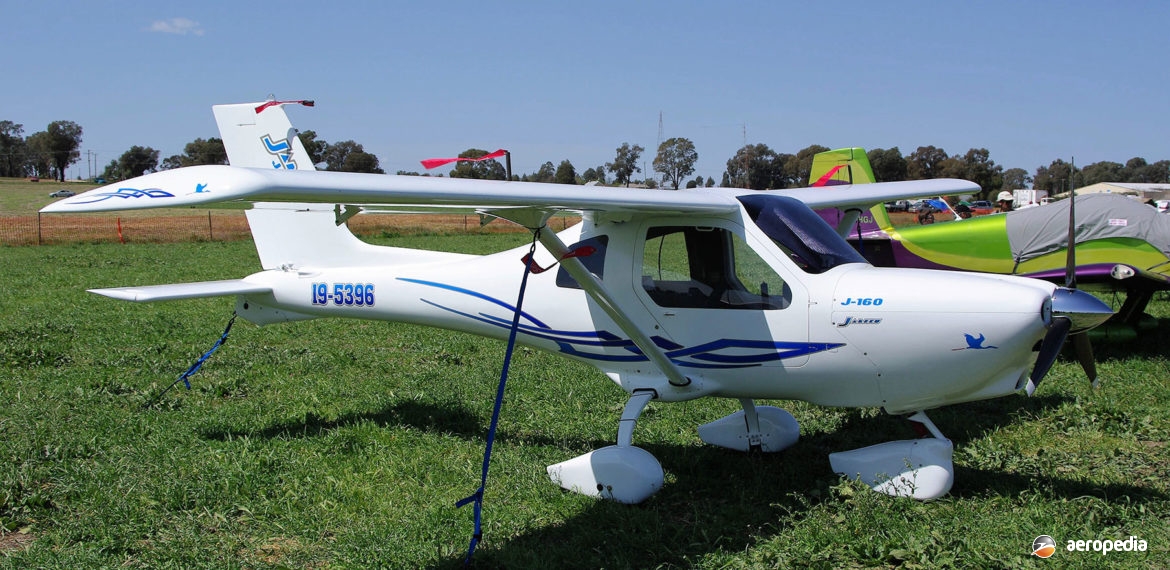Photograph:
Jabiru J-160 19-5396 (c/n 085) at Cowra, NSW in 2012 (David C Eyre)
Country of origin:
Australia
Description:
Two-seat light sport monoplane
Power Plant:
One 60 kw (80 hp) Jabiru 2200B four-cylinder horizontally-opposed air-cooled engine
Specifications:
- (J-160)
- Wingspan: 8.12 m (26 ft 7 in)
- Length: 5.77 m (18 ft 11 in)
- Height: 2.3 m (7 ft 6 in)
- Wing area: 8.04 m² (86.5 sq ft)
- Max speed: 213 km/h (132 mph)
- Cruising speed at 75% power: 185 km/h (115 mph)
- Stalling speed clean: 98 km/h (61 mph)
- Stalling speed full flap: 83 km/h (52 mph)
- Rate of climb at sea level: 152 m/min (500 ft/min)
- Service ceiling: 4,572 m (15,000 ft)
- Range: 1,908 km (1,186 miles)
- Endurance no reserve: 10.3 hours
- Fuel capacity: 135 litres (30 Imp gals)
- Take-off run: 210 m (650 ft)
- Landing run: 168 m (546 ft)
- Empty weight: 295 kg (649 lb)
- Useful load: 245 kg (539 lb)
- Loaded weight: 540 kg (1,188 lb)
History:
The Jabiru J-160 was designed to meet JAR-VLA European airworthiness standards by Jabiru Aircraft Pty Ltd of Bundaberg, QLD. It was a high-wing, strut-braced monoplane with electrically-operated wing flaps, mass balanced elevator and in-flight adjustable trim. It was of conventional light aircraft appearance and was powered by Jabiru’s own four-stroke 2200 engine. It was described as having a fully enclosed, ergonomically designed, cabin with two doors providing ease of entry, low noise levels, and excellent visibility. It had side-by-side seating with central controls and panel mounted throttles and was designed for training and recreational work. It was the culmination of the development of the smaller Jabiru aircraft to meet the requirements of recreational pilots in Australia and overseas.
The J-170 model was basically the J-160 with a lengthened wing and was aimed at the touring market, whereas the J-160 was optimized for the pilot training role. Both models had a tricycle undercarriage with a steerable nosewheel and hydraulic disc brakes. It was of all composite construction and was designed for minimum maintenance. The upper and lower engine cowls were easily removed. It had an auxiliary electronic fuel pump for ease of starting.
In early 2008 the Company announced a new model, the J-120, this being an updated variant of the earlier SP-500 and SP-470 models. This model included foam wings with a fuel tank at the rear of the cockpit and manual flaps, being powered by a 2200 cc Jabiru engine. The engine was housed under a lengthened cowling. The tail boom was also lengthened, and it had a larger fin and rudder. The cabin was of similar size to earlier models but it had larger doors. It was described as lighter, cleaner and faster, the first example of this model being shown at NATFLY at Narromine, NSW at Easter 2008.
The Jabiru series has been assembled and marketed in the Middle East and North Africa as the Yamamah Y-160, as the Y-430 by Seabird Aviation Jordan, and was marketed in the United Kingdom by Skycraft Ltd.

